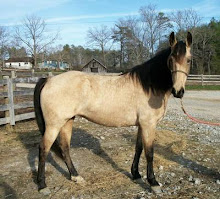I was talking to a friend yesterday who is an avid hiker. As part of that general 'update for friends you haven't seen for a while', I mentioned I had been doing a lot of trail riding this fall (exclude WEG timeframe!) and also working on trail issues in my job. She said "Most hikers don't want to walk on horse trails because they are so muddy and messy."
And therein lies the problem.
So we have to ask ourselves, are hikers oversensitive? Are they right about the muddiness? Do horseback riders have the reputation of coming in and just messing up the trails and not caring or not fixing them? Is the situation really as the hikers portray it?
First we need to admit that the laws of physics are at work. The heavier the load, the more the soil will respond. Horses are the heaviest non-motorized trail user based on both our total weight and the weight per square inch of footprint.
Secondly we need to look at the trail itself. Most trails of any type being used today fall into one of three categories, in terms of how and why they were built. 1. Built for just hikers, 2. Built as a roadbed for mining, timbering, oil & gas, fire access, etc. and 3. an existing wildlife trail.
These trails were never designed to take horses. In fact, most of them were not DESIGNED at all!
When these trails were created, people just didn't know what we know now in terms of engineering a trail to shed water, locating trails along contours, trail surfaces, stream crossings, etc. People did not realize how complex it is to properly locate a trail, pre-identify problem areas, and work to protect the trail against future problems (usually caused by water in some form.)
It's not that horseback riders are doing anything wrong as they ride. It is the trail that is not ready for anything but the lightest, most infrequent user.. or for trucks which use the trail for a year and then abandon it.
Failure of the trail surface is not at all surprising, at least in the sensitive areas where water is collecting or soils are such that they cannot hold the surface together.
And - and this is important that ALL users understand - it's really not just horses either. Footprints can cause the same damage. I wonder if hikers know this.
A footprint will not leave as DEEP an impression as a hoofprint, but it will leave a depression nevertheless, into which water will collect rather than disperse and run off the trail. In fact, here is a verbatim sentence from a Sierra Club announcement of a planned winter hike (on a hikers-only trail): "Hike is easy-to-moderate, with up to five miles of trails climbing and descending many hills, sometimes in muddy conditions." (Emphasis mine) Those hikers will go through the mud and disturb the trail, making footprints that will make it more difficult for the obviously existing water to drain. Or they will go around the muddy condition, widening the trail and having a bigger impact on the resource.
And mountain biking also causes problems on these un-engineered trails. A hydrologist can tell you that if you leave a wheeled footprint, it creates a natural gully into which which rain will rush down or fill, rather than that same rain dispersing over the trail and being absorbed by both the trail surface and the surrounding vegetation.
So everyone is at fault here, and no one is at fault. The ying-yang of trails.
What to do?
The first thing that horsemen need to do is be aware of the FACTS about the condition of all trails, whether hiker, biker or horse, and understand HOW and WHY they got that way. The details of the story will change depending on the trail type, topology of the land, shade v. sun, vegetation, soil type, etc. etc.
We should also note where GOOD horse trails are, ones which are in good shape regardless of use. Those trails have accidentally been placed such that water is running off the edge, soil types are conducive to the local conditions, and land contours have been followed.
And then, the next thing horsemen need to do is start working to change both the image and reality of horse trails. The image is that we ruin trails REGARDLESS OF THEIR LEVEL OF DESIGN and that WE DON'T CARE ABOUT OUR IMPACT. The reality is that we DO CARE because we want these trails to be there for a long time. The reality is that properly designed trails can easily take horse traffic without degradation. The reality is that ALL USERS have impact and to some degree the hikers are in a state of denial if they think that only horses cause damage. The reality is that horses DO have a greater impact because of weight and so we become the lightening rod for complaints.
But as that lightening rod, perhaps we can turn the situation around into one in which not only do horseback riders improve their reputations, but they also improve the trails which ALL USERS will benefit from.
I imagine a day when that Sierra Club hiker is on a trail, sees the spot that used to be muddy and is now fixed so it is dry and natural looking, with no walk-arounds and no mud puddles, and they say to themselves, "Looks like the horsemen have been here, fixing the trail. We need to be working on trails like the horsemen are."
Subscribe to:
Post Comments (Atom)

No comments:
Post a Comment